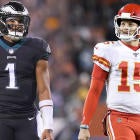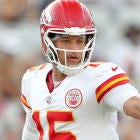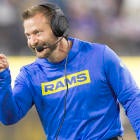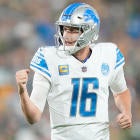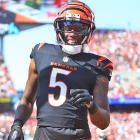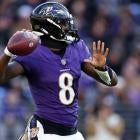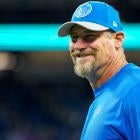
The Super Bowl is finally here. In a matchup that pits the No. 1 seed from each conference against each other, the Philadelphia Eagles and Kansas City Chiefs will battle it out on Sunday night to determine which team gets the right to call itself the champion of the 2022 NFL season.
There are star players galore who should be out in force for this game, from Patrick Mahomes and Jalen Hurts to Chris Jones and A.J. Brown, and from Haason Reddick and Travis Kelce to DeVonta Smith and Joe Thuney. Then there's Jason Kelce and Lane Johnson and Josh Sweat and Javon Hargrave and Fletcher Cox and Darius Slay and James Bradberry and Creed Humphrey and Trey Smith and Frank Clark and a whole lot more. And that's before we get to the star-studded coaching staffs, with Nick Sirianni, Shane Steichen, and Jonathan Gannon squaring off against Andy Reid, Eric Bieniemy, and Steve Spagnuolo. Oh, and did you know Reid used to work for the Eagles, while Sirianni began his NFL career in Kansas City? You have likely heard that by now.
Once the two teams take the field, all that matters is how their strengths and weaknesses collide. With that in mind, we are here once again to highlight the key players, X-factors, important battlegrounds, and more. Before we break down this epic matchup, here's a look at how you can watch the game.
How to watch
Date: Sunday, Feb. 12 | Time: 6:30 p.m. ET
Location: State Farm Stadium (Glendale, Arizona)
TV: Fox | Stream: fuboTV (try for free)
Follow: CBS Sports App
Odds: Eagles -1.5, O/U 51 (Courtesy of Caesars Sportsbook)
When the Chiefs have the ball
The single-most important matchup of this game might be the one in the trenches on this side of the ball.
Philadelphia led the NFL with 70 sacks during the regular season, and converted its pressure into sacks at a higher rate than any team in the NFL, according to TruMedia. The Eagles can come at you in waves, with Reddick, Sweat, Brandon Graham, Hargrave and Cox all providing high-level threats from different stations along the line of scrimmage. Meanwhile, the Chiefs' efforts to remake their offensive line during the offseason have gifted them with one of the league's top units, and one that is among the most well-equipped in the NFL to handle a top pass rush.
Reddick primarily rushes off the left side of the defense (77% of snaps, according to Pro Football Focus), while Sweat comes from the right side (86%) and Graham splits his time fairly equally. That means Reddick should spend most of his time tangling with Chiefs right tackle Andrew Wylie, while Sweat works across from Orlando Brown. The tackles are probably the two weakest links on the line, and Eagles defensive coordinator Jonathan Gannon's ability to generate one-on-one matchups in space for his edge rushers is extremely high level. How well Wylie and Brown hold up will obviously play a significant role in how much Mahomes has to try to move around and create outside of structure on his injured ankle.
Mahomes has become absolutely elite at avoiding sacks, getting taken down on only 3.9% of his dropbacks this season. No quarterback was sacked on a smaller share of his pressured dropbacks during the regular season than Mahomes (10.8%), who took a sack just over HALF as often as the league-average passer. Even while compromised over the past two games, he took just three sacks on more than 80 dropbacks. His ability to extend the play, and to sense when pressure is bearing down on him and get rid of the ball in a way that not only avoids the negative play, but gives the Chiefs a shot at an explosive gain, is unmatched leaguewide.
As we wrote earlier this week, the main threat when Mahomes looks down the field is very obviously Travis Kelce.
All season, the Kansas City passing game flowed through Kelce, who was targeted 152 times during the regular season -- 51 more than the next-closest player on the team (JuJu Smith-Schuster). With the recent injury issues to the Chiefs' wide receivers, Kelce has been even more of a focal point during the playoffs: He's been the targeted receiver on 25 of the team's 80 pass attempts during the playoffs, good for a 31.3% target share. That's up from 23.4% during the regular season.
Kelce and Mahomes have unrivaled chemistry, and they are able to threaten every area of the field. Still, most of their work is done in the short and intermediate areas, and especially over the middle. That makes Eagles linebackers T.J. Edwards and Kyzir White -- as well as safeties Chauncey Gardner-Johnson, Marcus Epps and Reed Blankenship -- arguably the most important defenders on the team for Sunday's game. That's the group that will most often have the responsibility of covering Kelce, whether the Eagles are playing man or zone.
Philadelphia acquitted itself well against tight ends this season, ranking sixth in Football Outsiders' DVOA on throws to players at the position. Of course, Kelce is not your standard tight end. During the regular season, the following tight ends ran at least 20 routes in a game against the Eagles: T.J. Hockenson, Johnny Mundt, Irv Smith Jr., Logan Thomas, Evan Engram, Zach Ertz, Peyton Hendershot, Pat Freiermuth, Brevin Jordan, Austin Hooper, Chigoziem Okonkwo, Daniel Bellinger, Cole Kmet, Dalton Schultz, Juwan Johnson, Nick Vannett and Lawrence Cager. (In the playoffs, they saw Bellinger again and then George Kittle, but the Niners literally did not have a quarterback capable of throwing the ball for most of the game.) Needless to say, there is not a player remotely in Kelce's league among that group. This is going to be a different type of challenge.
In particular, White has shown that you can take advantage of him when he's in coverage -- especially when he has to slide out to the slot and play in more space. Widening him out and running routes that circle in behind him and in front of the safeties has proven a successful strategy, and the Chiefs should be expected to employ it until he proves he can stop it. (Kelce was targeted on more than 25% of his routes when lined up in the slot, according to TruMedia, catching 53 of 69 passes for 657 yards and three touchdowns on those plays.) The way Mahomes and Kelce are able to work together to find soft spots in zone coverage makes his and Edwards' ability to tackle Kelce immediately and not let him gain yards after the catch incredibly important as well.
The safeties will also have to be on high alert for the freelance, out-of-structure playmaking Mahomes and Kelce get into when Mahomes breaks contain in the pocket. They've created a bunch of big plays in those situations, with Kelce either working back toward Mahomes or up the field and into open space. Keeping a roof on the defense and not allowing Kelce to get in behind them, and thus forcing the Chiefs to methodically work their way down the field, is Philly's best option.
The strength of Philly's back-end pass defense is on the perimeter, where Slay and Bradberry have been shutdown corners all year. That's not really where the Chiefs like to attack, but having a duo that is able to take away the threat posed by Marquez Valdes-Scantling as a deep target, without needing much in the way of safety help, should aid the linebackers in their task of dealing with Kelce, as the safeties can provide more help there.
The other challenge in dealing with the Kansas City passing game is that you have to be able to tackle right away. Kelce is an elite YAC threat, as is Kadarius Toney. Smith-Schuster created a bunch of yards with the ball in his hands this year as well, and Skyy Moore has breakaway speed if he ever gets into open space. Especially on schemed touches like swing passes and jet sweeps, the corners (particularly slot man Avonte Maddox) need to be on high alert and able to either make one-on-one tackles in space or else hold up long enough for help to arrive so they can make a gang tackle.
Philadelphia's defense is not as strong against the run (21st in Football Outsiders' DVOA) as it is against the pass (first), but opponents have largely proven unable to run the ball against the Eagles this year nonetheless, largely because they have been in comeback mode too often. Kansas City's run game was more effective this year on the back of Isiah Pacheco and Jerick McKinnon (as well as that offensive line) than it was with Clyde Edwards-Helaire as the primary ball-carrier, and it wouldn't be surprising to see the Chiefs try to get those guys moving downhill early in the game.
The Eagles, though, are typically just fine with that strategy if opponents want to use it. They are content to let teams try to matriculate the ball downfield in small increments and count on them to make a mistake, which they can often force with their ferocious pass rush. But that is also a style of defense the Chiefs specifically reoriented their offense this past offseason to beat. Teams dared them to move the ball in small chunks and try to put together 10- or 11-play drives all of last season, and it threw them off a bit. This year, they just put together those super-long drives and scored at the end. They are built to play that how. It'll be fascinating to see how that balance plays out.
When the Eagles have the ball
The best thing about the Eagles offense is its ability to shapeshift and beat a defense in the best way that defense should be beaten. As we wrote before the NFC title game, "Bad against the run? The Eagles will pound the rock all day, like they did in rushing for more than 250 yards in two different games against the Giants, and a preposterous 363 yards against the Packers. Weak against the pass? They'll light you up through the air, like when they had just 19 running back rushing attempts against 39 Hurts passes against the Titans, and he torched them for 380 yards and three scores."
No matter where your weak point is as a defense, the Eagles -- at least with Hurts under center -- have been able to find a way to exploit it. This week, it'll be interesting to see what they think the Chiefs' weak point is. Kansas City finished the season 15th in run defense DVOA and 20th against the pass. Opponents have typically wanted to run it against K.C. in order to keep Mahomes and Co. off the field, but just as they have often been unable to run on Philly because they're too busy playing from behind, the same has been true against the Chiefs.
Of course, Philadelphia has the ability to run the ball against anybody. The Eagles sport the NFL's best offensive line, a unit that has both maulers and athletic marvels, and their quarterback is one of the premier rushing threats in the spot. That combination allows them to threaten opponents with the run to every single gap, which in turn opens up their dangerous and dynamic play-action and run-pass option game, which forms the foundation of their aerial attack. Between Hurts, Miles Sanders, Kenneth Gainwell, and Boston Scott, they also have a variety of different types of rushing threats, which can keep defenses off-balance as they try to handle one or the other.
On the perimeter, the Eagles should have a decided advantage. As we wrote earlier this week, the most important battleground on this side of the ball will be how the Chiefs' rookie defensive backs (and third-year pro L'Jarius Sneed) are able to hold up against one of the NFL's premier wide-receiver duos.
Against the Bengals in the AFC title game, this group showed out. Going up against one of the best wide receiver duos in the NFL (Ja'Marr Chase and Tee Higgins), the quartet of Trent McDuffie, Jaylen Watson, Joshua Williams and Bryan Cook had one of their best collective games of the season. They accounted for all four pass breakups and both interceptions the Chiefs recorded against Joe Burrow, and helped hold the Bengals to just 7.5 yards per attempt overall.
Things will not get much easier for this group in the Super Bowl. If there is a pass-catching duo in the NFL that rivals Chase and Higgins, then A.J. Brown and DeVonta Smith are certainly up there on the list of contenders. They present a multitude of challenges, with Brown's physicality and ability to win the ball in the air and Smith's deep speed and body control testing opposing secondaries in different ways.
It will be interesting to see how the Chiefs choose to line up their corners here, because they have been willing to move McDuffie around quite a bit. During the latter portion of the regular season, he played most often in the slot. In the divisional round, he moved back outside as L'Jarius Sneed slid into the slot to cover Christian Kirk. In the conference championship, McDuffie was back inside. After Sneed left with a concussion, Williams slid into the No. 2 spot on the perimeter opposite Watson. The Chiefs would likely prefer to have Sneed on one of Brown or Smith rather than covering Quez Watkins or Zach Pascal, but Philly moves its receivers around often enough that it'll be difficult to ensure that matchup on every snap.
Either way, the Eagles are surely going to take their shots on the outside when they see that they have one-on-one coverage. Whether the rookies can hold up in those situations how many explosive plays Philly can generate through the passing game. Cook has a role in that as well, even as the team's third safety. His deflection of a Burrow deep ball in the AFC title game caused an interception, and if he can get over the top of a Hurts deep ball and turn a one-on-one into a one-on-two, it reduces the chances of that ball being completed.
Of course, the Philadelphia passing game is about more than Brown and Smith. The Eagles also have a high-level threat at tight end in Dallas Goedert. He's not Kelce, but he is a matchup nightmare nonetheless. Linebackers Nick Bolton and Willie Gay, and safeties Juan Thornhill and Justin Reid, will be tested in their ability to prevent him from gaining yards after the catch -- especially on screens, where Goedert is often the centerpiece of the action.
Really, though, the Chiefs' best chance of defensive success in this game comes not through their matchups, but their defensive coordinator. Spagnuolo is one of the NFL's best game-planners, and his exotic blitz packages have been known to throw off even the best of quarterbacks. Hurts sliced up blitzes this season when opponents played man coverage behind the play, but struggled when they sat in zone and brought rushers from different areas of the field. Expect Spagnuolo to try to exploit that on Sunday night. It helps that he also has Jones, who is able to win from any area along the defensive line -- as we saw during the AFC title game, where he had his first sack lined up on the interior and then the game-deciding play when lined up as an edge rusher. Philadelphia's offensive line is elite, but if Spags can find a way to break through with blitzes, stunts, and a superstar, the Chiefs have the potential to make the Eagles offense uncomfortable.
Working through all of these factors, it's clear to me that the Eagles have the best roster. They have advantages in the trenches and on the perimeter, probably on both sides of the ball. What they don't have, though, is Mahomes. And I can't bring myself to pick against him on the sport's biggest stage.
Prediction: Chiefs 26, Eagles 24








